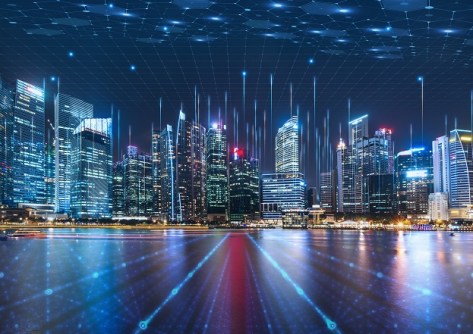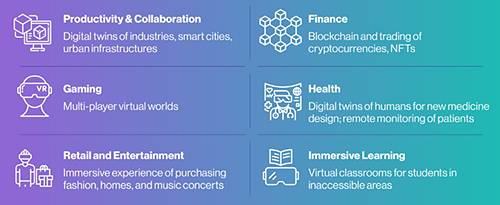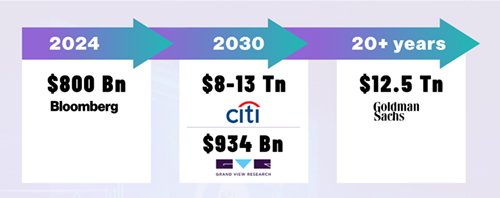
The geospatial sector is set to both underpin the metaverse and capitalise on the opportunities it presents.
By Jonathan Nally
It’s a buzzword that has been around for quite a few years, but for many people the ‘metaverse’ is still either a complete unknown or is something that applies only to gaming and entertainment. Yet whether we like it or not, and whether we understand it or not, the metaverse appears to be a concept that is here to stay and is growing in leaps and bounds.
So what is the metaverse and what will it do? It sort of depends on who you ask. According to the Metaverse Standards Forum, “The metaverse is motivating the novel integration and deployment of diverse technologies for collaborative spatial computing, such as interactive 3D graphics, augmented and virtual reality, photorealistic content authoring, geospatial systems, end-user content tooling, digital twins, real-time collaboration, physical simulation, online economies, multi-user gaming, and more — at new levels of scale and immersiveness.”
Neil Trevett, president of the The Khronos Group — a non-profit consortium of companies involved in 3D graphics, AR, VR and machine learning — says the metaverse will “bring together diverse technologies, requiring a constellation of interoperability standards, created and maintained by many standards organisations”.
“The metaverse will ultimately encompass all our activities and support them with applications. Just like standardisation has been an important foundation for open knowledge sharing and rapid development in the Web age, the same is true for the metaverse,” adds Arno Hollosi, CTO at Blackshark.ai.
All of this makes it sound as if the metaverse is tailor-made for the geospatial sector. Indeed, spatial data and technologies will themselves be some of the primary enabling factors underpinning the success of the entire concept.
Standardisation
Like any industry sector, or any profound technological development (e.g. electronics, computing, medicine), standardisation and interoperability will be one of the metaverse’s key drivers, making it possible for anyone, anywhere to contribute to and take advantage of what it has to offer.
“Technology and standards are the bricks and cement of the metaverse,” says Qi Wang, assistant president at 0xSenses. “Safe, reliable, and ethical interoperability is especially important as humans become part of the metaverse.”
The Metaverse Standards Forum, for instance, says that its mission is to “explore where the lack of interoperability is holding back metaverse deployment and how the work of Standards Developing Organizations (SDOs) defining and evolving needed standards may be coordinated and accelerated,” adding that it will “focus on pragmatic, action-based projects such as implementation prototyping, hackathons, plugfests, and open-source tooling to accelerate the testing and adoption of metaverse standards, while also developing consistent terminology and deployment guidelines.”
The Open Geospatial Consortium (OGC) has formed the OGC Geo For Metaverse Domain Working Group, which will “serve as a forum for the collective geospatial expertise of the OGC community to gather to help build and grow the open metaverse”.

According to the OGC, the metaverse is “perhaps the ultimate distributed digital twin of the world. It has the potential to represent everything in the world alongside imagined spaces. The challenges to Standards Development Organisations (SDOs), technologists, artists, and society are huge, but the payoff is believed to be equally tremendous. The metaverse is not a single thing but, like the internet, is a collection of platforms and technologies: a world of objects that can be navigated and interacted with.”
Importantly, the OGC says that the geospatial community can contribute to the success of the metaverse, via its “expertise in 3D, modelling and simulation, artificial intelligence, digital twins, streaming, augmented and virtual realities, routing, mapping, and more — all at scale”.
Commercial opportunities
Private companies and geospatial data providers are jumping on board, offering products and services that will see the sector grow.
For example, 12 months ago Maxar Technologies introduced SYNTH3D, which it describes as “a high-performance, geotypical 3D representation of the entire planet for gaming, simulation, entertainment, virtual reality (VR), smart cities and metaverse”.
SYNTH3D was developed in partnership with blackshark.ai, and according to Maxar enables “developers and creators to simulate and visualise 3D environments representative of real-world locations where aesthetics and performance are key to commercial applications”.
3D data visualisation firm, Cesium, has built a Smart Construction app for Komatsu, which uses 3D tiling pipelines and a visualisation engine to enable Komatsu to “monitor a construction site from anywhere in the world, watch how it changes over time, compare architectural plans with real-world data, and run precise and near real-time measurements”.
According to Airbus Intelligence, “For geospatial companies, the metaverse represents a tremendous opportunity”. It says that “geospatial companies will be asked to deliver massive quantities of data that are visually detailed, spatially accurate, and timely,” noting that “these metaverse requirements are the same as many current applications of geospatial data”.
Many large consultancies, software and hardware firms are eager to grab a slice of the metaverse pie; companies such as PWC, Accenture, Adobe, Deloitte, NVIDIA, Esri, Microsoft, Google, Meta, Woolpert, Oracle, Trimble, Planet, just to name a few. Qualcomm Ventures, for instance, has established the Snapdragon Metaverse Fund, with the aim of investing up to US$100 million in developers and companies innovating in the fields of AR, mixed reality and VR.
The opportunity is huge. According to a McKinsey study, more than US$120 billion of investment flowed into the metaverse in 2022, and more than 15% of corporate revenue is expected to arise from the metaverse in the next few years (according to 25% of the senior executives surveyed). McKinsey says the metaverse has the potential to generate up to US$5 trillion in value by 2030.
The geospatial metaverse
For the geospatial community, the metaverse presents exciting challenges, with plenty of scope for every private company, public sector organisation and research institution to get involved and capitalise on the opportunity.
In a landmark report released late last year, ‘Bringing Geospatial Context to the Metaverse: Considerations for the Next Steps,’ the World Geospatial Industry Council (WGIC) has outlined what the metaverse means for the sector, calling it “A digital, and therefore, virtual, representation of the universe”. The report:
- Examines metaverse market opportunities and risks for the geospatial sector.
- Looks at how the metaverse relates to concepts such as digital twins, cyber geography, and virtual reality.
- Presents a strategic outlook for developing a geospatial ecosystem in the metaverse.
The report also outlines four priority steps that will be needed to make this happen:
- Priority 1 involves understanding perceptions, since the metaverse will affect interactions between people and their world.
- Priority 2 will be to set up stakeholder engagement and collaboration across the private and public sectors.
- Priority 3 will be to understand the complexities of technological interoperability and data governance.
- Priority 4 will be to create the conditions under which the geospatial sector will be ready to grab the commercial opportunities inherent in the metaverse value chain.
The WGIC’s research has found that the metaverse market is going to be huge (see Figure 1): US$800 billion this year alone, and into the double-figure trillions in the 2030s.

The WGIC report says that “the metaverse will require geospatial approaches, technology, and experience at its foundations,” adding, however, that it is “essential to note that some milestones and challenges already exist or would arise during the construction of the geospatial foundations of the metaverse”.
It also says, however, that “Several synergies exist between the geospatial domain and the metaverse, where the geospatial offerings naturally address the core needs of the metaverse formation”. Such existing capabilities include:
- The ability to have an online presence across multiple devices
- Data and technology suitable for real-time productivity scenarios
- Real-time interoperability on a massive scale
- User control of content and creation
- Automation and performance enhancement using AI/ML
- Production of 3D content and modelling for virtual worlds
Reaching the metaverse
There’s no doubt that the basic technologies exist (or can be foreseen) for making the metaverse a reality, and that the geospatial sector will have a crucial role to play in its realisation. The WGIC’s four priority steps will provide vital guidance in this regard. Yet it is important to remember that, according to the organisation, the achievement of such milestones requires “engaging with topics that are generally not widely discussed within the geospatial industry. These issues include political drivers, social concerns of the public and governments, value propositions to investors and companies, and technological challenges such as hardware, data, software, and governance interoperability”.
The WGIC makes it clear that the four steps don’t need to be tackled sequentially — they can operate in parallel.
Enabling Priority 1, understanding societies’ perceptions, will take a lot of work, as there are many aspects to consider. While there is some awareness of the metaverse amongst the public and policymakers, a concerted effort will need to be made to reassure them of the value of the metaverse and to dispel or deal with fears regarding AI, deep fakes, trust in data and so on. Many national governments are taking steps to deal with those challenges, but it remains to be seen how successful they will be and whether piecemeal approaches will hinder uptake of metaverse solutions.
Priority 2, stakeholder engagement, will go a long way to assuring the success of Priority 1. The WGIC particularly recommends deep engagement with governments, industry groups and expert consortia.
The WGIC says that Priority 3, tackling the complexities of technological interoperability and data governance, “are perhaps the most well-understood of all future issues”. It cites the excellent work being done by the Metaverse Standards Forum and the OGC in this regard, and notes that the development of a Universal Digital Twin and ensuring the quality of visualisation will be important foci.
Priority 4, the creation of economic opportunities and market readiness markers, poses some challenges, with experts consulted by the WGIC offering the following advice:
- To kick-start momentum, a unique value proposition, even if simple, must demonstrate the value of bringing geospatial context to the metaverse.
- Symbiotic business models (e.g. public-private partnerships) and other revenue generation (e.g. data licensing, IPR) have to be developed for a tangible and enduring return on investment.
- There is a need to overcome a measure of risk aversion for companies to invest funds and time in developing ideas and offerings.
In summary, the WGIC says that “The metaverse represents a significant opportunity for the geospatial industry to develop new products and services, generate new revenue streams, and create new jobs. However, it also presents several risks the geospatial ecosystem must address to ensure the ethical and responsible use of geospatial data in the metaverse”.
This article was first published in Issue 129 (Feb/Mar 2024) of Position magazine. Please consider subscribing.







